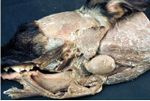Difference between revisions of "Mandibular Gland - Anatomy & Physiology"
Jump to navigation
Jump to search
m (Text replace - "Category:Alimentary System" to "Category:Alimentary System - Anatomy & Physiology") |
m (Text replace - "Oral Cavity - Salivary Glands - Anatomy & Physiology" to "Salivary Glands - Anatomy & Physiology") |
||
| Line 4: | Line 4: | ||
|linktext =Alimentary System | |linktext =Alimentary System | ||
|maplink = | |maplink = | ||
| − | |sublink1= | + | |sublink1=Salivary Glands - Anatomy & Physiology#Major Salivary Glands |
|subtext1=MAJOR SALIVARY GLANDS | |subtext1=MAJOR SALIVARY GLANDS | ||
}} | }} | ||
Revision as of 16:16, 4 September 2010
|
|
Mandibular Salivary Gland
- Merocrine secretion
- Generally smaller than the parotid gland
- It is a moderately large gland in carnivores
- It is a large gland in herbivores
- Compact
- Located around angle of jaw
- Mandibular duct runs ventral to mucous membrane of floor of oral cavity, close to frenulum of tongue
- Duct opens at sublingual caruncle
Histology
- Tubulo-acinar gland
- Mucous cells (stain lighter)
- Serous demilunes (stain darker)
- Demilunes secrete into lumen by canaliculi between mucous cells
Species Differences
Carnivores
- Mainly mucous secretion in dog and cat
- Oval shape in canid
Herbivores
- Larger and deeper
